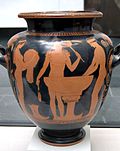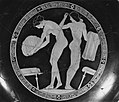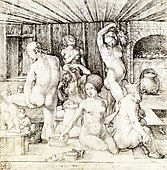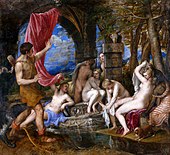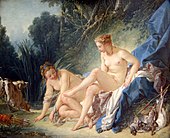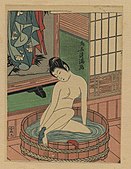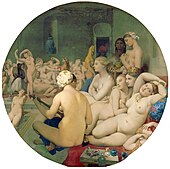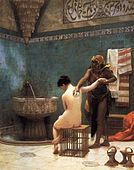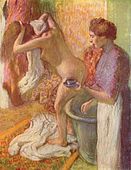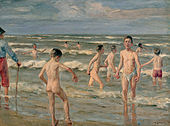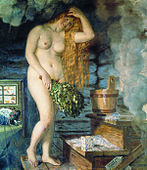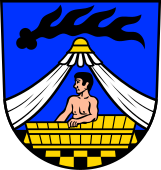Bathing


Bathingis the immersion of the body, wholly or partially, usually in water, but often in another medium such as hot air. It is most commonly practised as part of personal cleansing, and less frequently for relaxation or as a leisure activity. Cleansing the body may be solely a component ofpersonal hygiene,but is also a spiritual part of somereligious rituals.Bathing is also sometimes used medically or therapeutically, as inhydrotherapy,ice baths,or themud bath.
People bathe in water at temperatures ranging from very cold to very hot, or in appropriately heated air, according to custom or purpose.
Where indoor heated water is available, people bathe more or less daily, at comfortable temperatures, in a private bathtub or shower.Communal bathing,such as that in hammams, sauna, banya, Victorian Turkish baths, andsentō,fulfils the same purpose, in addition to its often having a social function.
Ritual religious bathing is sometimes referred to asimmersion.This can be required after sexual intercourse or menstruation (Islam and Judaism), or asbaptism(Christianity).
By analogy, the term "bathing" is also applied to rela xing activities in which the participant "bathes" in the rays of the sun (sunbathing) or in outdoorbodies of water,such as insea bathingorwild swimming.
Although there is sometimes overlap, as in sea bathing, most bathing is usually treated as distinct from more active recreations likeswimming.
History
[edit]Ancient world
[edit]Bathing in Ancient China may be traced back to theShang Dynasty,3000 years ago (1600–1046 BCE).[citation needed]Archaeological findings from theYinxuruins show a cauldron to boil water, smaller cauldrons to draw out the water to be poured into a basin, skin scrapers to remove dirt and dead skin.[1]2300 year old lavish imperial bathrooms with exquisite tiles and a sewage system can be seen in Xi'an.[2][better source needed]Bathing grew in importance in the Han Dynasty (202 BC–AD 220) where officials were allowed to take a day's leave for bathing at home every five days, and bathing became the reason for abank holidayfor the first time.[citation needed]
An accountable daily ritual of bathing can be traced to theancient Indians.[citation needed]They used elaborate practices for personal hygiene with three daily baths and washing. These are recorded in the works calledgrihya sutraswhich date back to 500 BCE and are in practice today in some communities. In Hinduism, “Prataha Kaal”(the onset of day) or “Brahma Muhoortham”begins with the 4 am “snanam”or bath, and was considered extremely auspicious in ancient times.[citation needed]
Ancient Greeceutilized small bathtubs, wash basins, and foot baths for personal cleanliness. The earliest findings of baths date from the mid-2nd millennium BC in the palace complex atKnossos,Crete, and the luxurious alabaster bathtubs excavated inAkrotiri,Santorini.A word for bathtub,asaminthos(ἀσάμινθος), occurs eleven times in Homer. As a legitimate Mycenaean word (a-sa-mi-to) for a kind of vessel that could be found in any Mycenaean palace, thisLinear Bterm derives from an Aegean suffix-inth-being appended to an Akkadian loan word with the rootnamsû('washbowl', 'washing tub'). This luxurious item of the Mycenaean palace culture, therefore, was clearly borrowed from the Near East.[3]Later Greeks established public baths and showers within gymnasiums for relaxation and personal hygiene. The wordgymnasium(γυμνάσιον) comes from the Greek wordgymnos(γυμνός), meaning "naked".
Ancient Romedeveloped a network ofaqueductsto supply water to all large towns and population centers and had indoor plumbing, with pipes that terminated in homes and at public wells and fountains. TheRoman public bathswere calledthermae.The thermae were not simply baths, but important public works that provided facilities for many kinds of physical exercise and ablutions, with cold, warm, and hot baths, rooms for instruction and debate, and usually one Greek and one Latin library. They also represented an important moment of socialization and exchange between the members of the community.[4]They were provided for the public by a benefactor, usually the Emperor. Other empires of the time did not show such an affinity for public works, but this Roman practice spread their culture to places where there may have been more resistance to foreign mores. Unusually for the time, the thermae were not class-stratified, being available to all for no charge or a small fee. With thefall of the Roman Empire,the aqueduct system fell into disrepair and disuse. But even before that, during the Christianization of the Empire, changing ideas about public morals led the baths into disfavor.
Medieval Japan
[edit]Before the 7th century, the Japanese were likely to have bathed in the many springs in the open, as there is no evidence of closed rooms. In the 6th to 8th centuries (in theAsukaandNara periods) the Japanese absorbed the religion of Buddhism from China, which had a strong impact on the culture of the entire country. Buddhist temples traditionally included a bathhouse (yuya) for the monks. Due to the principle of purity espoused by Buddhism these baths were eventually opened to the public. Only the wealthy had private baths.
The first public bathhouse was mentioned in 1266. InEdo(modern Tokyo), the firstsentōwas established in 1591. The early steam baths were callediwaburo(Nham phong Lữ"rock pools" ) orkamaburo(Phủ phong Lữ"furnace baths" ). These were built into natural caves or stone vaults. Iniwaburoalong the coast, the rocks were heated by burning wood, then sea water was poured over the rocks, producing steam. The entrances to these "bath houses" were very small, possibly to slow the escape of the heat and steam. There were no windows, so it was very dark inside and the user constantly coughed or cleared their throats in order to signal to new entrants which seats were already occupied. The darkness could be also used to cover sexual contact. Because there was no gender distinction, these baths came into disrepute. They were finally abolished in 1870 on hygienic and moral grounds. Author John Gallagher says bathing "was segregated in the 1870s as a concession to outraged Western tourists".[5]
At the beginning of theEdo period(1603–1868) there were two different types of baths. In Edo, hot-water baths ('Canh phòngyuya) were common, while in Osaka, steam baths (Chưng phong Lữmushiburo) were common. At that time shared bathrooms for men and women were the rule. These bathhouses were very popular, especially for men. "Bathing girls" (Canh nữyuna) were employed to scrub the guests' backs and wash their hair, etc. In 1841, the employment ofyunawas generally prohibited, as well asmixed bathing.The segregation of the sexes, however, was often ignored by operators of bathhouses, or areas for men and women were separated only by a symbolic line. Today,sentobaths have separate rooms for men and women.[6]
Mesoamerica
[edit]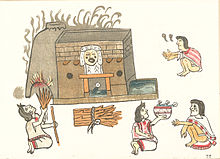
Spanishchronicles describe the bathing habits of the peoples ofMesoamericaduring and after theconquest. Bernal Díaz del CastillodescribesMoctezuma(the Mexica, or Aztec, king at the arrival ofCortés) in hisHistoria verdadera de la conquista de la Nueva Españaas being "...Very neat and cleanly, bathing every day each afternoon...". Bathing was not restricted to the elite, but was practised by all people; the chronicler Tomás López Medel wrote after a journey toCentral Americathat "Bathing and the custom of washing oneself is so quotidian (common) amongst the Indians, both of cold and hot lands, as is eating, and this is done in fountains and rivers and other water to which they have access, without anything other than pure water..."[7]
The Mesoamerican bath, known astemazcalinSpanish,from the Nahuatl wordtemazcalli,a compound oftemaz( "steam" ) andcalli( "house" ), consists of a room, often in the form of a small dome, with an exterior firebox known astexictle(teʃict͜ɬe) that heats a small portion of the room's wall made of volcanic rocks; after this wall has been heated, water is poured on it to produce steam, an action known astlasas.As the steam accumulates in the upper part of the room a person in charge uses a bough to direct the steam to the bathers who are lying on the ground, with which he later gives them a massage, then the bathers scrub themselves with a small flat river stone and finally the person in charge introduces buckets with water with soap and grass used to rinse. This bath had also ritual importance, and was vinculated to the goddessToci;it is also therapeutic when medicinal herbs are used in the water for thetlasas.It is still used inMexico.[7]
Medieval and early-modern Europe
[edit]
Christianityhas always placed a strong emphasis onhygiene.[8]Despite the denunciation of themixed bathingstyle of Roman pools byearly Christianclergy, as well as the pagan custom of women bathing naked in front of men, this did not stop the Church from urging its followers to go to public baths for bathing,[9]which contributed to hygiene and good health according to theChurch Fathers,Clement of AlexandriaandTertullian.The Church also builtpublic bathingfacilities that were separate for both sexes near monasteries and pilgrimage sites; also, the popes situated baths within church basilicas and monasteries since the early Middle Ages.[10]PopeGregory the Greaturged his followers on value of bathing as a bodily need.[11]
Greatbathhouseswere built inByzantine centerssuch asConstantinopleandAntioch,[12]and thepopesallocated to the Romans bathing throughdiaconia,or privateLateranbaths, or even a myriad of monasticbath housesfunctioning in eighth and ninth centuries.[11]ThePopesmaintained their baths in their residences which described by scholar Paolo Squatriti as "luxurious baths", andbath housesincluding hot baths incorporated into Christian Church buildings or those of monasteries, which known as "charity baths"because they served both the clerics and needy poor people.[13]Public bathingwas common in larger towns and cities such asParis,RegensburgandNaples.[14][15]The Catholic religious orders of theAugustiniansandBenedictineshad rules forritual purification,[16]and inspired byBenedict of Nursiaencouragement for the practice of therapeutic bathing;Benedictinemonks played a role in the development and promotion ofspas.[17]Protestantismalso played a prominent role in the development of the Britishspas.[17]
In theMiddle Ages,bathing commonly took place inpublic bathhouses.Public baths were also havens forprostitution,which created some opposition to them. Rich people bathed at home, most likely in their bedroom, as "bath" rooms were not common. Bathing was done in large, wooden tubs with a linen cloth laid in it to protect the bather from splinters. Additionally, during theRenaissanceandProtestant Reformation,the quality and condition of the clothing (as opposed to the actual cleanliness of the body itself) were thought to reflect the soul of an individual. Clean clothing also reflected one's social status; clothes made the man or woman.
Due to Black Death plague, introduced from Asia to Europe, public baths were closed to avoid contagion.[18][19][20]In the sixteenth century, the popularity of public bathhouses in Europe sharply declined, perhaps due to the new plague ofsyphiliswhich made sexual promiscuity more risky, or stronger religious prohibitions on nudity surrounding theProtestant Reformation.[21][22]Some Europeans came to believe the false idea that bathing or steaming would openporesto disease.[23]
Modern era
[edit]Therapeutic bathing
[edit]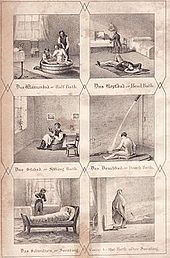
Public opinion about bathing began to shift in the middle and late 18th century, when writers argued that frequent bathing might lead to better health. Two English works on the medical uses of water were published in the 18th century that inaugurated the new fashion fortherapeutic bathing.One of these was by SirJohn Floyer,a physician ofLichfield,who, struck by the remedial use of certain springs by the neighbouring peasantry, investigated the history of cold bathing and published a book on the subject in 1702. [24]The book ran through six editions within a few years and the translation of this book into German was largely drawn upon by Dr J. S. Hahn ofSilesiaas the basis for his book calledOn the Healing Virtues of Cold Water, Inwardly and Outwardly Applied, as Proved by Experience,published in 1738.[25]
The other work was a 1797 publication by DrJames CurrieofLiverpoolon the use of hot and cold water in the treatment of fever and other illness, with a fourth edition published not long before his death in 1805.[26]It was also translated into German by Michaelis (1801) andHegewisch(1807). It was highly popular and first placed the subject on a scientific basis. Hahn's writings had meanwhile created much enthusiasm among his countrymen, societies having been everywhere formed to promote the medicinal and dietetic use of water; in 1804 Professor E.F.C. Oertel ofAnspachrepublished them and quickened the popular movement by the unqualified commendation of water drinking as a remedy for all diseases. [27]
A popular revival followed the application of hydrotherapy around 1829, byVincenz Priessnitz,a peasant farmer inGräfenberg,then part of theAustrian Empire.[28] [29]This revival was continued by a Bavarian priest,Sebastian Kneipp(1821–1897), "an able and enthusiastic follower" of Priessnitz, "whose work he took up where Priessnitz left it", after he read a treatise on the cold water cure.[30]InWörishofen(south Germany), Kneipp developed the systematic and controlled application of hydrotherapy for the support of medical treatment that was delivered only by doctors at that time. Kneipp's own bookMy Water Curewas published in 1886 with many subsequent editions, and translated into many languages.
Captain R. T. Claridgewas responsible for introducing and promoting hydropathy in Britain, first in London in 1842, then with lecture tours in Ireland and Scotland in 1843. His 10-week tour in Ireland included Limerick, Cork, Wexford, Dublin and Belfast,[31]over June, July and August 1843, with two subsequent lectures in Glasgow.[32]

The acceptance ofgerm theoryin the late 1800s provided scientific reasons for frequent bathing.
Public baths and wash-houses
[edit]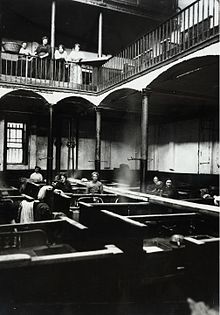
Large public baths such as those found in the ancient world and theOttoman Empirewere revived during the 19th century. The first modern public baths were opened inLiverpoolin 1829. The first known warm fresh-waterpublic wash housewas opened in May 1842.[13]: 2–14 [33]
The popularity of wash-houses was spurred by the newspaper interest inKitty Wilkinson,an Irish immigrant "wife of a labourer" who became known as theSaint of the Slums.[34]In 1832, during acholeraepidemic, Wilkinson took the initiative to offer the use of her house and yard to neighbours to wash their clothes, at a charge of a penny per week,[13]and showed them how to use achloride of lime(bleach) to get them clean. She was supported by the DistrictProvident SocietyandWilliam Rathbone.In 1842, Wilkinson was appointed baths superintendent.[35][36]
In Birmingham, around ten private baths were available in the 1830s. Whilst the dimensions of the baths were small, they provided a range of services.[37]A major proprietor of bath houses in Birmingham was a Mr. Monro who had had premises in Lady Well and Snow Hill.[38]Private baths were advertised as having healing qualities and being able to cure people ofdiabetes,goutand all skin diseases, amongst others.[38]On 19 November 1844, it was decided that theworking classmembers of society should have the opportunity to access baths, in an attempt to address the health problems of the public. On 22 April and 23 April 1845, two lectures were delivered in thetown hallurging the provision of public baths in Birmingham and other towns and cities.
After a period of campaigning by many committees, thePublic Baths and Wash-houses Actreceivedroyal assenton 26 August 1846. The act empoweredlocal authoritiesacross the country to incur expenditure in constructing public swimming baths out of its own funds.[39]
The first London public baths was opened at Goulston Square,Whitechapel,in 1847 with thePrince consortlaying the foundation stone.[40][41]
Soap promoted for personal cleanliness
[edit]
By the mid-19th century, the English urbanised middle classes had formed an ideology of cleanliness that ranked alongside typicalVictorianconcepts, such asChristianity,respectability andsocial progress.[42]The cleanliness of the individual became associated with his or her moral and social standing within the community and domestic life became increasingly regulated by concerns regarding the presentation of domestic sobriety and cleanliness. [43]
The industry of soapmaking began on a small scale in the 1780s, with the establishment of a soap manufactory atTiptonbyJames Keirand the marketing of high-quality, transparent soap in 1789 byAndrew PearsofLondon.It was in the mid-19th century, though, that the large-scale consumption of soap by the middle classes, anxious to prove their social standing, drove forward the mass production and marketing of soap.
William Gossageproduced low-priced, good-quality soap from the 1850s.William Hesketh Leverand his brother, James, bought a small soap works inWarringtonin 1886 and founded what is still one of the largest soap businesses, formerly called Lever Brothers and now calledUnilever.These soap businesses were among the first to employ large-scaleadvertisingcampaigns.
Before the late 19th century, water to individual places of residence was rare.[44]Many countries in Europe developed a water collection and distribution network.London water supply infrastructuredeveloped through major 19th-century treatment works built in response tocholerathreats, to modern large-scale reservoirs. By the end of the century, private baths with running hot water were increasingly common in affluent homes in America and Britain.
At the beginning of the 20th century, a weekly Saturday night bath had become common custom for most of the population. A half day's work on Saturday for factory workers allowed them some leisure to prepare for theSunday day of rest.The half day off allowed time for the considerable labor of drawing, carrying, and heating water, filling the bath and then afterward emptying it. To economize, bath water was shared by all family members. Indoor plumbing became more common in the 20th century and commercial advertising campaigns pushing new bath products began to influence public ideas about cleanliness, promoting the idea of a daily shower or bath.[citation needed]
In the twenty-first century challenges to the need for soap to effect such everyday cleanliness and whether soap is needed to avoid body odor, appeared in media.[45]
Hot-air baths
[edit]Hammam
[edit]
Ahammam[a]is a type ofsteam bathor a place ofpublic bathingassociated with theIslamic world.It is a prominent feature in theculture of the Muslim worldand was inherited from the model of theRomanthermae.[46][47][48]Muslim bathhouses or hammams were historically found across theMiddle East,North Africa,al-Andalus(Islamic Spain and Portugal),Central Asia,theIndian subcontinent,and inSoutheastern EuropeunderOttoman rule.
In Islamic cultures the significance of the hammam was both religious and civic: it provided for the needs ofritual ablutionsbut also provided for generalhygienein an era before private plumbing and served other social functions such as offering a gendered meeting place for men and for women.[46][47][49]Archeologicalremains attest to the existence of bathhouses in the Islamic world as early as theUmayyad period(7th–8th centuries) and their importance has persisted up to modern times.[46][49]Their architecture evolved from the layout of Roman andGreekbathhouses and featured a regular sequence of rooms: anundressing room,acold room,awarm room,and ahot room.Heat was produced byfurnaceswhich provided hot water andsteam,while smoke and hot air was channeled throughconduits under the floor.[47][48][49]
In a modern hammam visitors undress themselves, while retaining some sort of modesty garment orloincloth,and proceed into progressively hotter rooms, inducingperspiration.They are then usually washed by male or female staff (matching the gender of the visitor) with the use of soap and vigorous rubbing, before ending by washing themselves in warm water.[49]Unlike in Roman or Greek baths, bathers usually wash themselves with running water instead of immersing themselves in standing water since this is a requirement of Islam,[47]though immersion in a pool used to be customary in the hammams of some regions such asIran.[50]While hammams everywhere generally operate in fairly similar ways, there are some regional differences both in usage and architecture.[49]
Victorian Turkish baths
[edit]
Victorian Turkish baths(inspired by the traditional Islamic bathhouse—the hammam—itself an adaptation of theancient Roman baths) were introduced to Britain byDavid Urquhart,diplomat and sometime Member of Parliament for Stafford. He wanted, for political and personal reasons, to popularize Turkish culture in Britain. In 1850 he wroteThe Pillars of Hercules,[51]a book about his travels in 1848 through Spain and Morocco. He described the vaporous hot-air baths (little-changed since Roman times) which he visited, both there and in the Ottoman Empire. In 1856Dr Richard Barterread Urquhart's book and worked with him to construct such a bath, intending to use it at hishydropathic establishmentat St Ann(e)'s Hill, near Blarney, County Cork, Ireland.[52]Barter realised that the human body could tolerate the more therapeutically effective higher temperatures in hot air which was dry rather than steamy. After a number of unsuccessful attempts, he opened the first modern bath of this type in 1856. He called it the "Improved" Turkish or Irish bath,[53]now better known as the Victorian Turkish bath.
The following year, the first public bath of its type to be built in mainland Britain since Roman times was opened in Manchester,[54]and the idea spread rapidly. It reached London in July 1860, when Roger Evans, a member of one of Urquhart's Foreign Affairs Committees, opened a Turkish bath at 5 Bell Street, near Marble Arch.[55]During the following 150 years, over 700 Turkish baths opened in the British Isles, including those built by municipal authorities as part of swimming pool complexes. It was claimed by Durham Dunlop (and many others) that hot-air bathing was a more effective body-cleanser than water,[56]while Richard Metcalfe meticulously calculated that it would be more cost-effective for local authorities to provide hot-air baths in place of slipper baths.[57]
Turkish baths opened in other parts of the British Empire. Dr. John Le Gay Brereton opened one in Sydney, Australia in 1859,[58]Canada had one by 1869,[59]and the first in New Zealand was opened in 1874.[60]Urquhart's influence was also felt outside the Empire when in 1861, Dr Charles H. Shepard opened the first Turkish baths in the United States at 63 Columbia Street, Brooklyn Heights, New York, most probably on 3 October 1863.[61]
Purpose
[edit]One purpose of bathing is forpersonal hygiene.It is a means of achievingcleanlinessby washing away dead skin cells, dirt, and soil and as a preventative measure to reduce the incidence and spread of disease. It also may reducebody odors,however, some people note that may not be so necessary as commonly thought.[45]
Bathing creates a feeling of well-being and the physical appearance of cleanliness.
Bathing may also be practised for religiousritualor therapeutic purposes[62]or as a recreational activity. Bathing may be used to cool or to warm the body of an individual.
Therapeutic use of bathing includeshydrotherapy,healing, rehabilitation from injury or addiction, and relaxation.
The use of a bath in religious ritual or ceremonialritesinclude immersion duringbaptismin Christianity and to achieve a state of ritual cleanliness in amikvahin Judaism. It is referred to asGhuslin Arabic to attain ceremonial purity (Taahir) in Islam. All major religions place an emphasis on ceremonial purity, and bathing is one of the primary means of attaining outward purity. In Hindu households, any acts of defilement are countered by undergoing a bath and Hindus also immerse in Sarovar as part of religious rites. In the Sikh religion, there is a place atGolden Templewhere the leprosy ofRajni's husband was cured by immersion into the holy sacred pool, and many pilgrims bathe in the sacred pool believing it will cure their illness as well.
Types of baths
[edit]This sectionneeds expansion.You can help byadding to it.(October 2023) |


Where bathing is for personal hygiene, bathing in abathtuborshoweris the most common form of bathing in Western, and many Eastern, countries. People most commonly bathe in their home or use a private bath in a public bathhouse. In some societies, bathing can take place in rivers, creeks, lakes or water holes, or any other place where there is an adequate pool of water. The quality of water used for bathing purposes varies considerably. Normally bathing involves use ofsoapor a soap-like substance, such as shower gel. In southern India people more commonly use aromatic oil and other home-made body scrubs.
Bathing in publiccan also provide occasions for social interaction, such as inTurkish,banya,sauna,hammams,orwhirlpoolbaths.
Sponge bath
[edit]When water is in short supply or a person is not fit to have a standing bath, a wet cloth orspongecan be used, or the person can wash by splashing water over their body. A sponge bath is usually conducted in hospitals, which involves one person washing another with asponge,while the person being washed remains lying in bed.
Ladling water from a container
[edit]
This method involves using a small container to scoop water out of a large container and pour water over the body, in such a way that this water does not go back into the large container.
In Indonesia and Malaysia, this is a traditional method referred to asmandi.
In the Indonesian language,mandiis the verb for this process;bak mandiis the large container, andkamar mandiis the place in which this is done.[63][64]Travel guides often use the wordmandion its own or in various ways such as for the large container and for the process of bathing.[65][66]
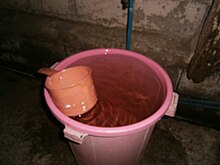
In the Philippines,timba(pail) andtabo(dipper) are two essentials in every bathroom.
Bathing babies
[edit]Babies can be washed in a kitchen sink or a small plasticbaby bath,instead of using a standard bath which offers little control of the infant's movements and requires the parent to lean awkwardly or kneel.[67]Bathing infants too often has been linked to the development ofasthmaor severeeczemaaccording to some researchers, including Michael Welch, chair of theAmerican Academy of Pediatrics' section on allergy and immunology.[68]A safe temperature for the bathwater is generally held to be 32–38 °C (90–100 °F).[69]
Japanese bathing culture
[edit]Private baths
[edit]
Today, most homes in Japan have a bathroom (ofuro), which was often not the case about 30 years ago. Bath water in Japan is much hotter than what is usual in Central Europe. The temperature is usually well above 40 °C (104 °F). In medical literature, 47 °C (117 °F) is considered bearable.[70]The heat is considered a prerequisite for complete relaxation. The custom is to thoroughly clean oneself with soap and rinse before entering the tub, so as not to contaminate the bath water.
Public baths
[edit]
In public baths, there is a distinction between public baths with natural hot springs (calledonsen,meaning 'hot'), and those without natural hot springs (known assento). Since Japan is located in a volcanically active region, there are many hot springs, of which about 2,000 are swimming pools. Mostonsenare in the open countryside, but they are also found in cities. In Tokyo, for example, there are about 25onsenbaths.Onsenare similar to Western-style spas in their therapeutic use of natural hot springs.
Anonsenconsists mostly of outdoor pools (rotenburo), which are sometimes at different temperatures. Extremely hot springs, where even experienced or frequent hot-spring bathers can only stay a few minutes, are calledjigoku('hell'). Manyonsenalso have saunas, spa treatments and therapy centers. The same rules apply in public baths as in private baths, with bathers required to wash and clean themselves before entering the water. In general, the Japanese bathe naked in bathhouses; bathing suits are not permissible.[citation needed]
Art motif
[edit]Bathing scenes were already in the Middle Ages a popular subject of painters. Most of the subjects were women shown nude, but the interest was probably less to the bathing itself rather than to provide the context for representing thenudefigure. From the Middle Ages, illustrated books of the time contained such bathing scenes. Biblical and mythological themes which featured bathing were depicted by numerous painters. Especially popular themes includedBathsheba in the bath,in which she is observed by King David, andSusannain the sight of lecherous old men.
In the High Middle Ages, public baths were a popular subject of painting, with rather clear depictions of sexual advances, which probably were not based on actual observations. During theRenaissanceandBaroqueperiods, the gods and nymphs ofGreek mythologywere depicted bathing in allegorical paintings by artists such asTitianandFrançois Boucher,both of whom painted the goddessDianabathing. Artists continued to paint Biblical characters bathing, and also sometimes depicted contemporary women bathing in the river, an example beingRembrandt'sWoman Bathing.
In the 19th century, the use of the bathing scene reached its high point inclassicism,realismandimpressionism.Oriental themes and harem andturkish bathsscenes became popular. These scenes were based on the artists' imagination, because access by men to Islamic women was not generally permitted.[72]In the second half of the century, artists increasingly eschewed the pretexts of mythology and exoticism, and painted contemporary western women bathing.Edgar Degas,for example, painted over 100 paintings with a bathing theme. The subject of Bathers remained popular inavant-gardecircles at the outset of the 20th century.
-
Albrecht Dürer,Women bathing,1496
-
Lucas Cranach,The Golden Age,1530
-
Titian,Actaeon Surprises Diana in Her Bath,1559
-
Wolfgang Heimbach,People Bathing,1640
-
François Boucher,Diana Leaving Her Bath,1742
-
Torii Kiyomitsu,Bathing Woman,1750
-
Jean-Léon Gérôme,The Bath,ca. 1880
-
Edgar Degas,After the Bath,ca. 1890
-
Paul Gauguin,By the Sea,1892
-
Paul Cézanne,The Large Bathers(detail)
-
Lawrence Alma-Tadema,The Baths atCaracalla,1899
-
Max Liebermann,Bathing Boys,1900
-
Joaquín Sorolla y Bastida,Sad Inheritance,1900. Crippled children bathing at the sea in Valencia
-
Anders Zorn,Girls from Dalarna Having a Bath,1906
-
Ernst Ludwig Kirchner,The Soldier Bath,1915
-
Pierre-Auguste Renoir,The bathing women,1919
-
Boris Kustodiev,Russian Venus,1926
-
Pablo Picasso,Quatre baigneuses (Four Bathers),1922, CollectionPaul Allen
-
In the German spa townBad Liebenzellthe bather is part of the municipalCoat of arms
See also
[edit]Notes
[edit]References
[edit]- ^"The King Demands Hot Water – The 'National Treasures' and Washing Implements of the King of the Shang Dynasty".Museum of the Institute of History & Philology, Academia Sinica.Archivedfrom the original on 2022-11-25.Retrieved2022-11-25.
- ^"Archaeologists discover 2,000-year-old luxury baths in China".Business Standard.6 November 2017.Archivedfrom the original on 25 November 2022.Retrieved25 November2022.
- ^Reece, Steve, "The Homeric Ἀσάμινθος: Stirring the Waters of the Mycenaean Bath,"Mnemosyne: A Journal of Classical Studies55.6 (2002) 703–708.The Homeric AsaminthosArchived2019-12-31 at theWayback Machine
- ^Mirza, Shalra (2023-07-25)."Roman Baths: Ancient Hygiene, Healing, and Socialization | History Cooperative".Retrieved2024-10-17.
- ^Gallagher, J. (2003).Geisha: A Unique World of Tradition, Elegance, and Art.London: PRC Pub. p. 87.ISBN1856486974
- ^Badehäuser, Schwitzbäder, Heisse Quellen.Katalog der Staatlichen Museen zu Berlin, Berlin 1997.
- ^abNoriega Hernández, Joana Cecilia (March 2004)."El baño temascal novohispano, de Moctezuma a Revillagigedo. Reflexiones sobre prácticas de higiene y expresiones de sociabilidad"(PDF).izt.uam.mx.Archived fromthe original(PDF)on 2013-04-06.Retrieved2012-12-18.
- ^Warsh, Cheryl Krasnick(2006).Children's Health Issues in Historical Perspective.Veronica Strong-Boag. Wilfrid Laurier Univ. Press. p. 315.ISBN9780889209121.
... From Fleming's perspective, the transition to Christianity required a good dose of personal and public hygiene...
- ^Warsh, Cheryl Krasnick (2006).Children's Health Issues in Historical Perspective.Veronica Strong-Boag. Wilfrid Laurier Univ. Press. p. 315.ISBN9780889209121.
... Thus bathing also was considered a part of good health practice. For example, Tertullian attended the baths and believed them hygienic. Clement of Alexandria, while condemning excesses, had given guidelines for Christians who wished to attend the baths...
- ^Thurlkill, Mary (2016).Sacred Scents in Early Christianity and Islam: Studies in Body and Religion.Rowman & Littlefield. pp. 6–11.ISBN978-0739174531.
... Clement of Alexandria (d. c. 215 CE) allowed that bathing contributed to good health and hygiene... Christian skeptics could not easily dissuade the baths' practical popularity, however; popes continued to build baths situated within church basilicas and monasteries throughout the early medieval period...
- ^abSquatriti, Paolo (2002).Water and Society in Early Medieval Italy, AD 400-1000, Parti 400–1000.Cambridge University Press. p. 54.ISBN9780521522069.
... but baths were normally considered therapeutic until the days of Gregory the Great, who understood virtuous bathing to be bathing "on account of the needs of body"...
- ^Kazhdan, Alexander,ed. (1991),Oxford Dictionary of Byzantium,Oxford University Press,ISBN978-0-19-504652-6
- ^abcAshpitel, Arthur (1851),Observations on baths and wash-houses,JSTOR60239734,OCLC315673477
- ^Black, Winston (2019).The Middle Ages: Facts and Fictions.ABC-CLIO. p. 61.ISBN9781440862328.
Public baths were common in the larger towns and cities of Europe by the twelfth century.
- ^Kleinschmidt, Harald (2005).Perception and Action in Medieval Europe.Boydell & Brewer. p. 61.ISBN9781843831464.
The evidence of early medieval laws that enforced punishments for the destruction of bathing houses suggests that such buildings were not rare. That they... took a bath every week. At places in southern Europe, Roman baths remained in use or were even restored... The Paris city scribe Nicolas Boileau noted the existence of twenty-six public baths in Paris in 1272
- ^Hembry, Phyllis (1990).The English Spa, 1560–1815: A Social History.Fairleigh Dickinson Univ Press.ISBN9780838633915.
- ^abBradley, Ian (2012).Water: A Spiritual History.Bloomsbury Publishing.ISBN9781441167675.
- ^Achtman, M.; Zurth, K.; Morelli, G.; Torrea, G.; Guiyoule, A.; Carniel, E. (1999-11-23)."Yersinia pestis, the cause of plague, is a recently emerged clone of Yersinia pseudotuberculosis".Proceedings of the National Academy of Sciences of the United States of America.96(24): 14043–14048.Bibcode:1999PNAS...9614043A.doi:10.1073/pnas.96.24.14043.ISSN0027-8424.PMC24187.PMID10570195.
- ^McNally, Alan; Thomson, Nicholas R.; Reuter, Sandra; Wren, Brendan W. (2016)."'Add, stir and reduce': Yersinia spp. as model bacteria for pathogen evolution ".Nature Reviews. Microbiology.14(3): 177–190.doi:10.1038/nrmicro.2015.29.ISSN1740-1534.PMID26876035.
- ^Glatter, Kathryn A.; Finkelman, Paul (2021)."History of the Plague: An Ancient Pandemic for the Age of COVID-19".The American Journal of Medicine.134(2): 176–181.doi:10.1016/j.amjmed.2020.08.019.ISSN0002-9343.PMC7513766.PMID32979306.
- ^"Bathing in the Middle Ages".Archivedfrom the original on 2023-08-15.Retrieved2023-08-15.
- ^"What did Medieval People Really Wear?".Archivedfrom the original on 2023-08-15.Retrieved2023-08-15.
- ^"What history's bathing rituals reveal about status, purity and power".Archivedfrom the original on 2023-08-15.Retrieved2023-08-15.
- ^John Floyer & Edward Batnard (1715) [1702].Psychrolousia. Or, the History of Cold Bathing: Both Ancient and Modern. In Two Parts. The First, written by Sir John Floyer, of Litchfield. The Second, treating the genuine life of Hot and Cold Baths..(exceedingly long subtitles) by Dr. Edward Batnard.London: William Innys. Fourth Edition, with Appendix.Retrieved2009-10-22.Full text at Internet Archive (archive.org)
- ^Hahn, J.S. (1738).On the Power and Effect of Cold Water.Cited in Richard Metcalfe (1898), pp.5–6. PerEncyclopædia Britannica,this was also titledOn the Healing Virtues of Cold Water, Inwardly and Outwardly applied, as proved by Experience
- ^Currie, James (1805). "Medical Reports, on the Effects of Water, Cold and Warm, as a remedy in Fever and Other Diseases, Whether applied to the Surface of the Body or used Internally".Including an Inquiry into the Circumstances that render Cold Drink, or the Cold Bath, Dangerous in Health, to which are added; Observations on the Nature of Fever; and on the effects of Opium, Alcohol, and Inanition.Vol. 1 (4th, Corrected and Enlarged ed.). London: T. Cadell and W. Davies.Retrieved2 December2009.Full text at Internet Archive (archive.org)
- ^Claridge, Capt. R.T. (1843, 8th ed), pp.14 49, 54, 57, 68, 322, 335. Note: Pagination in online field does not match book pagination. Type "Oertel" into search field to find citations.
- ^Claridge, Capt. R.T. (1843).Hydropathy; or The Cold Water Cure, as practiced by Vincent Priessnitz, at Graefenberg, Silesia, Austria(8th ed.). London: James Madden and Co.Retrieved2009-10-29.Full text at Internet Archive (archive.org). Note: The "Advertisement", pp.v-xi, appears from the 5th ed onwards, so references to time pertain to time as at 5th edition.
- ^Bradley, James (2003).Cold cure: Hydrotherapy had exotic origins, but became a firm favourite of the Victorian elite.Wellcome Trust: News and Features. Archived fromthe originalon 11 October 2010.Retrieved17 November2009.
- ^Kneipp, Sebastian (1891).My Water Cure, As Tested Through More than Thirty Years, and Described for the Healing of Diseases and the Preservation of Health.Edinburgh & London: William Blackwood & Sons.Retrieved3 December2009.translation from the 30th German edition. Full text at Internet Archive (archive.org).
- ^Beirne, Peter.The Ennis Turkish Baths 1869–1878.County Cork Library. p. see note 11.Archivedfrom the original on 2 February 2010.Retrieved30 October2009.Originally published inThe Other Clarevol. 32 (2008) pp 12–17
- ^Anon. (1843).Hydropathy, or the Cold Water Cure.The Substance of Two Lectures, delivered by Captain Claridge, F.S.A., at the Queens Concert Rooms, Glasgow.Retrieved12 June2010.
- ^Metcalfe, Richard (1877),Sanitas Sanitatum et Omnia Sanitas,vol. 1, Co-operative printing company, p. 3
- ^"'Slum Saint' honoured with statue ".BBC News.4 February 2010.Archivedfrom the original on 23 March 2022.Retrieved9 June2014.
- ^Wohl, Anthony S. (1984),Endangered lives: public health in Victorian Britain,Taylor & Francis, p. 73,ISBN978-0-416-37950-1
- ^Rathbone, Herbert R. (1927),Memoir of Kitty Wilkinson of Liverpool, 1786-1860: with a short account of Thomas Wilkinson, her husband,H. Young & Sons
- ^Topography of Warwickshire,William West, 1830
- ^abThe Birmingham Journal:Private Bath Advertisements, 17 May 1851
- ^"Baths and Wash-Houses".The Times.22 July 1846. p. 6.
Yesterday the bill, as amended by the committee, for promoting the voluntary establishment in boroughs and parishes in England and Wales of public baths and wash-houses was printed.
- ^"Classified Advertising".The Times.26 July 1847. p. 1.
Model Public Baths, Goulston-square, Whitechapel. The BATHS for men and boys are now OPEN from 5 in the morning till 10 at night. Charges – first-class (two towels), cold bath 5d., warm bath 6d.; second-class (one towel), cold bath 1d, warm bath 2d. Every bath is in a private room.
- ^Metcalfe, Richard (1877),Sanitas Sanitatum et Omnia Sanitas,vol. 1, Co-operative printing company, p. 7
- ^Eveleigh, Bogs (2002).Baths and Basins: The Story of Domestic Sanitation.Stroud, England: Sutton.
- ^"Health & Hygiene in Nineteenth Century England".Archivedfrom the original on 22 November 2020.Retrieved23 May2019.
- ^The Western Heritage(2004) by Donald Kagan, Steven E Ozment, and Frank M Turner.ISBN0-13-182839-8
- ^abFleming, Amy,‘I don’t smell!’ Meet the people who have stopped washingArchived2023-07-24 at theWayback Machine,The Guardian, August 5, 2019
- ^abcM. Bloom, Jonathan and S. Blair, Sheila, eds. (2009). 'Bath' InThe Grove Encyclopedia of Islamic Art and Architecture.(Oxford University Press.)
- ^abcdSibley, Magda.The historic hammams of Damascus and Fez: lessons of sustainability and future developments.The 23rd Conference on Passive and Low Energy Architecture.
- ^abMarçais, Georges (1954).L'architecture musulmane d'Occident.(Paris: Arts et métiers graphiques)
- ^abcdeSourdel-Thomine, J. and Louis, A. 'Ḥammām'. In Bearman, P. and others (eds.).Encyclopaedia of IslamSecond Edition. (Leiden: Brill, 2012).
- ^Blake, Stephen P. 'Hamams in Mughal India and Safavid Iran: climate and culture in two early modern Islamic empires'. In Ergin, Nina (ed.).Bathing culture of Anatolian civilizations: architecture, history, and imagination.(Leuven: Peeters, 2011). pp.257–266. ISBN 9789042924390.
- ^Urquhart, David (1850)The Pillars of Hercules, or, a narrative of travels in Spain & Morocco in 1848.Vol.2 (London: Bentley) pp.18–88
- ^Shifrin, Malcolm (2015).Victorian Turkish baths.(Swindon: Historic England) pp.21—25; 49—50. ISBN 978-1-84802-230-0
- ^'The Improved Turkish or Irish bath' [Advert].Waterford Mail(1 March 1861) p.2
- ^Potter, William. 'The Turkish bath'.Sheffield Free Press(18 July 1857) p.3
- ^Goolden, R.H. 'The Turkish bath'Lancet(26 January 1861) pp.95—97
- ^Dunlop, Durham. (1880).The philosophy of the bath: with a history of hydro-therapeutics and of the hot-air bath from the earliest ages.4th edition. (London: W. Kent) pp.208-209
- ^Metcalfe, Richard. (1877)Sanitas sanitatum et omnia sanitas.Vol.1 (All published) (London: Co-operative Printing Co.) pp.151—170
- ^'The Turkish bath'Sydney Morning Herald(13 October 1859) p.4
- ^'The modern Turkish or Roman bath'Industries of Canada: City of Montreal…(Montreal: Historical Publ Co, 1886) p.134
- ^[The Otago Turkish Bath Company]Tuapeka Times(21 March 1874) p.2
- ^'The Turkish baths in Brooklyn'Brooklyn Daily Eagle(19 October 1863) p.3
- ^Shove, Elizabeth (2004).Comfort, Cleanliness and Convenience The Social Organization of Normality (New Technologies/New Cultures).New York: Berg.ISBN978-1-85973-630-2.
- ^From theKamus Besar Bahasa Indonesia,fourth edition:
mandiv.to wash one's body with water and soap (by pouring water over or soaking one's body, etc.) [membersihkan tubuh dng air dan sabun dng cara menyiramkan, merendamkan diri ke air, dsb.] p.871
bak mandin.something used to hold water for bathing [kolam tempat air untuk mandi], p. 121
kamar mandin.place for bathing [bilik tempat mandi], p. 611
- ^"Indonesia: Indonesian culture".All Experts.11 December 2005. Archived fromthe originalon 5 July 2011.Retrieved8 March2011.
- ^"East Timor"(PDF).Lonely Planet.Indonesia.Archived fromthe original(PDF)on 2011-06-07.Retrieved2011-03-08.
Cheaper hotels, where they exist, may not have running water or showers. Washing facilities are likely to be Indonesianmandistyle, something with which travellers who have been off the beaten track in Indonesia will be familiar. Amandiis a large water tank, from which you scoop water with a ladle, jug or what looks like a plastic saucepan. Once wet, you soap yourself down and then rinse the soap off with more water from themandi.You certainly do not climb into themandi.
- ^"Indonesia".Tactile Interactive.Archived fromthe originalon 2022-06-27.Retrieved2012-06-22.
- ^"Bathing your baby"Archived2012-11-27 at theWayback Machine,babycentre.co.uk. Retrieved May 4, 2014.
- ^Geddes, Jennifer Kelly."Too Many Baths?".Parenting.Archived fromthe originalon 4 May 2014.Retrieved4 May2014.
- ^Elizabeth PantleyGentle Baby Care- 2003 0071504664 Page 43 "Fill the tub with the bathwater that is warm, not hot. Thoroughly mix the hot and cold water, then check the temperature with your elbow or wrist, or use a baby bath thermometer to keep the temperature of the bathwater between 90 ̊F (32 ̊C) and 100 ̊F (38 ̊C)..
- ^K.Kubota, K.Tamura, H.Take, H.Kurabayashi, M.Mori, T.Shirakura:Dependence on very hot hot-spring bathing in a refractory case of atopic dermatitis.in:Journal of medicine.25.1994, 5,333–336.ISSN0025-7850
- ^Photo from "Sketches of Japanese Manners and Customs", by J. M. W. Silver.ISBN978-1-4346-9833-9.
- ^Alev Lytle Croutier:Wasser. Elixier des Lebens.Heyne, München 1992, S. 187 ff.ISBN3-453-05924-7


